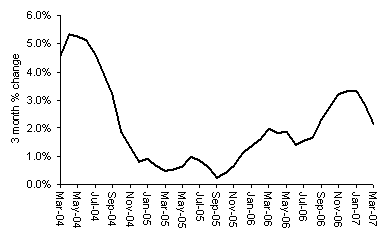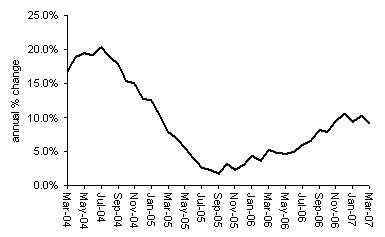- Types of Mortgage Explained
- Which Mortgage Type Is Right For Me?
- Mortgage Repayment Guide
- Remortgage Guide
- First Time Buyer Mortgages
- House Price Comparison
- How Much Can I Borrow
- Joint Ownership
Specialist UK Mortgages...
Spring loses some bounce
- House price inflation slowed to 9.3% in March
- Underlying trend softening as interest rate rises feed through
- But supply constraints will continue to support prices
- US sub-prime woes unlikely to cross the pond, but highlight the wisdom of prudence
Headlines |
March 2007 |
February 2007 |
Monthly index * Q1 '93 = 100 |
353.6 |
352.4 |
Monthly change* |
0.4% |
0.6% |
Annual change |
9.3% |
10.2% |
Average price |
£177,083 |
£174,706 |
* seasonally adjusted
Commenting on the figures Fionnuala Earley, Nationwide's Chief Economist, said:
“The housing market showed further signs of cooling during March. The price of a typical house increased by 0.4% during the month, bringing the annual rate of house price inflation back into single digits at 9.3%. The price of a typical property in the UK is now £177,083, £15,000 higher than at this time last year. This is the equivalent of a monthly rise of £1,250 per month or £41 per day.
Annual rate remains firm, but underlying trend cools…
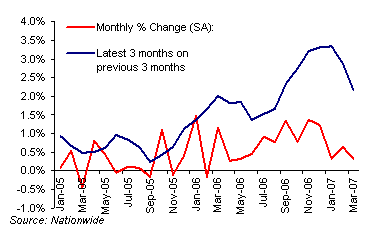 “While the annual rate of house price inflation has yo-yoed over the last few months, the underlying trend is clearly softening as interest rate rises take effect. Prices have risen by an average of 0.4% per month this year, compared with 1.1% in the last three months of 2006. The three monthly growth rate of 2.1% is at its lowest since August. Leading indicators of house price inflation also suggest that the underlying trend will continue to slow this year. Mortgage approvals and buyer enquiries at estate agents have weakened since the start of the year and we expect that this will continue as the dampening effect of the earlier interest rate rises feed through. Our forecast of house price growth of 5-8% in 2007 still looks on track, and implies price rises averaging between 0.4% and 0.7% per month for the rest of the year.
“While the annual rate of house price inflation has yo-yoed over the last few months, the underlying trend is clearly softening as interest rate rises take effect. Prices have risen by an average of 0.4% per month this year, compared with 1.1% in the last three months of 2006. The three monthly growth rate of 2.1% is at its lowest since August. Leading indicators of house price inflation also suggest that the underlying trend will continue to slow this year. Mortgage approvals and buyer enquiries at estate agents have weakened since the start of the year and we expect that this will continue as the dampening effect of the earlier interest rate rises feed through. Our forecast of house price growth of 5-8% in 2007 still looks on track, and implies price rises averaging between 0.4% and 0.7% per month for the rest of the year.
…although supply constraints will continue to support prices
“In spite of the cooling in demand, the UK housing market will remain fairly firm in the short term, partly because of the momentum built up in the market that will take a few months to work through, but also because of supply constraints. Not only are insufficient numbers of homeowners putting their properties on the market, but levels of house building continue to undershoot the levels of demand. New data from the government shows an even higher expected number of household formations, yet house building targets remain woefully low, especially in parts of the South East.
“New calculations mean that the number of households projected to be formed in England each year has increased to 223,000, up from the projection of 209,000 this time last year. However, with current rates of house building running at around 200,000 per year, this leaves a shortfall of over 20,000 frustrated households. With higher immigration assumptions, the annual projection increases to 255,000 per year, making a shortfall of 55,000.
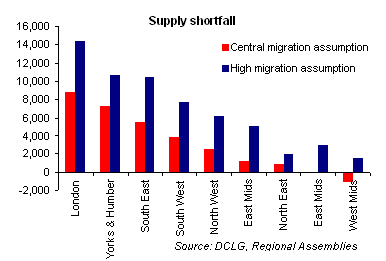
“Across England the biggest pressures are in London and the South East where one third of growth in the total number of English households is expected to be. Current building plans allow for only 60,000 units per year, but the household projections suggest that there is potential demand of between 74,000 and 84,000 each year.
US sub-prime troubles unlikely to affect the UK…
“Trouble in the US sub-prime mortgage markets led to shock waves in global equity markets and concerns about a potential collapse of the US housing market. Sickly profits at one of the main UK sub-prime lenders has led to some concern on this side of the pond that the UK may be in for the same experience. However, while there are some similarities between the two markets in terms of rising prices, rising interest rates and deteriorating affordability, the US experience is far more extreme. Eleven increases in rates in the States over the last two years, amounting to a 2.75% point increase, makes the UK experience of only a net 0.50% point rise in the same period look tame. In addition, exposure to the more vulnerable sub-prime market in the US is much greater. Looking forward, the prevalence of ‘teaser rate’ loans in the States is likely to make the situation even worse. Two thirds of those on adjustable rate mortgages in the States are expected to face payment shocks of more than 25% and 20% of them a shock of 50% . With house prices stagnating and even falling in some areas, the options for borrowers unable to pay are a little bleak.
“In contrast, the relaxation of credit criteria in the UK has been more controlled and the exposure to sub-prime lending is much smaller. The average loan to value ratio has been broadly stable at 80% for the last year and is much lower than the 87% of ten years ago. Mortgage payments as a percentage of take home pay, even for first time buyers, have some way to go before reaching the dizzy levels of the late 1980s. Back then, mortgage payments accounted for more than 55% of the take home pay of someone on average earnings. Today, while still high, that proportion is much lower at around 44%. Payment shock is also much more muted, with the three increases in rates adding about £54 (around 8%) to the monthly payment of a loan of around £120,000. Furthermore, tight supply conditions and still rising prices means that borrowers who get into difficulties have more opportunity to trade out of their situation.
…but will shine the light on lending standards
“Clearly, worsening affordability increases the risks of borrowing at high income multiples, particularly when interest rates are rising. However while arrears and possessions in the UK are rising, they remain at very low levels when compared with the past. Furthermore the outlook for the economy and particularly the labour market remains buoyant. Nevertheless, the experience in the States undoubtedly shines the light on the UK and highlights the wisdom of prudence.
Budget did nothing to ease stamp duty burden
“The final Brown Budget was overall fairly neutral with most of the major fiscal announcements not coming in until the 2008/9 financial year. The Chancellor did not choose to ease the stamp duty burden by indexing the thresholds, even though he has benefited enormously from the rise in house prices throughout his term at No 11. Back in financial year 1997/8 the Treasury’s revenue from stamp duty was only £830 million whereas in 2006/7 we estimate the coffers will be swelled by more than five times this amount at £4.6 billion.
Fionnuala Earley Katie Harper
Chief Economist Press Officer
Tel: 01793 656370 Tel: 01793 656215
fionnuala.earley@nationwide.co.uk katie.harper@nationwide.co.uk
Long Term Real House Price Trend
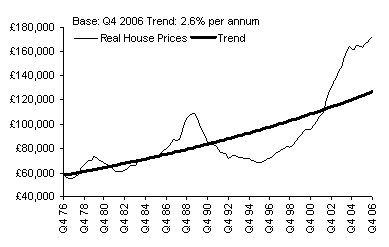
Average UK House Price
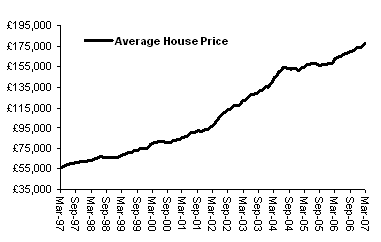
3 months on previous 3 months % change
Annual % Change in House Prices
Historical Data

Notes:
Indices and average prices are produced using Nationwide's updated mix adjusted House Price Methodology which was introduced with effect from the first quarter of 1995. Price indices are seasonally adjusted using the US Bureau of the Census X12 method. Currently the calculations are based on a monthly data starting from January 1991. Figures are recalculated each month which may result in revisions to historical data.
The Nationwide Monthly House Price Index is prepared from information which we believe is collated with care, but no representation is made as to its accuracy or completeness. We reserve the right to vary our methodology and to edit or discontinue the whole or any part of the Index at any time, for regulatory or other reasons. Persons seeking to place reliance on the Index for their own or third party commercial purposes do so entirely at their own risk. All changes are nominal and do not allow for inflation.
Think carefully before securing other debts against your home, your home may be repossessed if you do not keep up repayments on your mortgage.
Go Direct.co.uk is a trading style for website purposes of Go Direct UK Ltd.
Go Financial Services is a trading style of Go Direct UK Ltd which is an appointed representative of Personal Touch Financial Services Ltd which is authorised and regulated by the Financial Conduct Authority. Registered in England & Wales Company 5703224. FCA Number 456600
We normally do not charge a fee for mortgage advice, however this is dependent on your circumstances. Our typical fee would be £349





